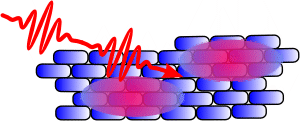Dynamics in Microcrystalline Films and Supramolecular Structures

Fast processes in highly ordered organic systems are relevant for the application of these systems in organic electronics. One project deals with the dynamics of photoinduced electronic excitation in pentacene films. This material is used for many prototype applications in organic electronics and serves as model system to explore the possibilities of plastic electronics. The transformation of light in electrical signals or power and vice versa is of particular interest, since it is the base of illumination devices, solar cells, as well as many sensor and data processing technologies. However, contrary to most other applied organic materials, crystalline pentacene shows after electronic excitation no emission of light. The mechanism of this radiationless deactivation should be relevant for optoelectronic applications. Several possibilities like the ultrafast generation of free charges or triplet excitons have been discussed. To investigate this problem we excited crystalline pentacene films with 30 fs long laser pulses and probed the subsequent evolution of the film transmission. The results show that the light emission after electronic excitation is indeed switched off within only 70 fs. However, the dominant channel is neither the charge nor the triplet generation. Rather the pentacene molecules rearrange in such a way that the lowest electronically excited state has a negligible transition dipole to the ground state. The subsequent dynamics is governed by diffusion controlled annihilation and trapping processes. From its analysis we can deduce the mobility of the electronic excitations and the concentration of traps. In the future we want to characterize the structural changes associated with these processes. Aggregates are promising supramolecular structures for directed energy and charge transport. In first experiments on perylenebisimide aggregates we see that the original fluorescence is quenched within 200 fs due to structural rearrangements. These changes of the local geometry result in an immobilization of electronic excitations. Further studies should clarify how this immobilization can be switched on and off.
Kontakt
Institut für Physik
AG Dynamik molekularer Systeme
Albert-Einstein-Straße 23-24
18059 Rostock
Tel: 0381 498 6960
